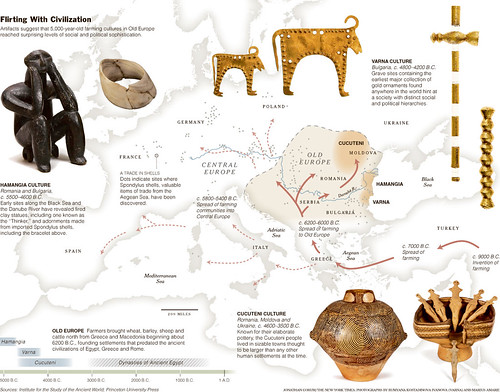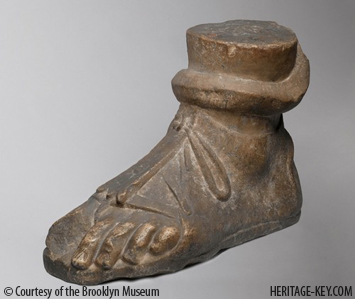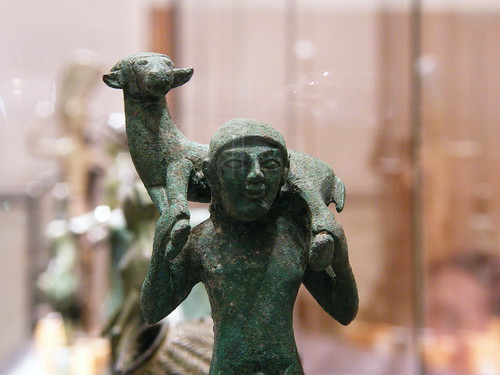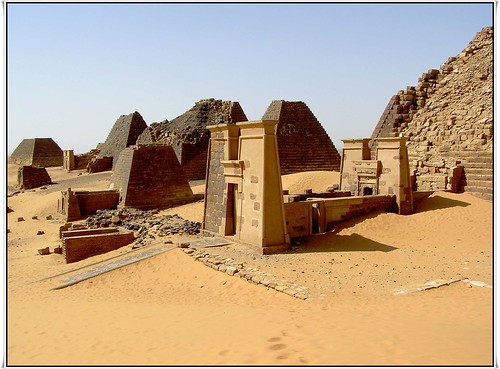A trip to India with my photographer husband, Tim, found us celebrating the New Year in Varanasi, India. There’s actually almost nothing physically ancient in what claims to be the oldest continually inhabited city on earth. The city was once ruled by King Ashoka, but the Moguls, who invaded from the North and ruled India for nearly two hundred years ending 1707, made rubble of the place, and so you look in vain for anything built before the 18th century (although check out the ancient Dhamek Stupa – one of the few surviving ancient sites – if you visit). However,…
-
-
The exhibition “The Lost World of Old Europe,” which opened in Nov. 2009 in New York, has raised some very interesting questions about prehistoric societies and how they changed. David Anthony, guest curator of the exhibition and a leading anthropologist specializing in prehistoric Europe, Eurasia, and North America, raised a particularly powerful issue – why did the collapse of a highly sophisticated, matriarchal culture in what is now Bulgaria, Romania, and Moldova, lead to a shift of power to men? Women, after all, are naturally capable of running households, and should surely be running countries too. Think of our powerful,…
-
I dropped my phone last week and it stopped working. As the daughter, sister, and wife of engineers, I generally regard most broken things as a challenge and I am quite often able to fix them, so I gathered tiny screwdrivers and a good light source and prised the handset open. Inside was a world mostly unknown to me, of miniature circuit boards, teeny candy-striped transistors, and delicate little welds. I identified the problem, but it was beyond repair, so I went out and bought another phone with a renewed respect for the intricacies inside the things we use every…
-
Women invented metallurgy! This extraordinary revelation was made in a lecture last night at New York University’s Institute for the Study of the Ancient World (which has an unfortune acronym pronounced eyesore) by David Anthony, Professor of Anthropology at Hartwick College and Guest Curator of the exhibition currently on view at ISAW until April 25, 2010: “The Lost World of Old Europe: The Danube Valley, 5000-3500 BC.” In his talk, entitled “The Rise and Fall of Old Europe,” Anthony delved into the mysteries of the highly sophisticated and populous culture that sprang up 7,000 years ago along the banks of…
-
I got a jump on the Queen of England the other day, and visited the newly-opened wing of the Ashmolean Museum of Art & Archaeology in Oxford a full week before she officially opens it Dec. 2. My parents live in Oxford, and I was visiting them unexpectedly (death in my husband’s family). They had tried to visit the Museum at the weekend, but queues that snaked round the block drove them back, so my father and I took a secondwalk over there on a quieter Wed. afternoonto see what all the fuss was about. First off, I should confess…
-
The Nubians get short shrift when it comes to recognition of significant ancient cultures. A new exhibition at the Clay Center in West Virginia, US, hopes to rectify that. It is cleverly entitled: Lost Kingdoms of the Nile, but the artefacts are all Nubian, not Egyptian. (The subtitle is: Nubian Treasures from the Museum of Fine Arts Boston.) The exhibition runs from Sept. 12, 2009 to April 11, 2010. Part of the problem for the Nubians, of course, is the rock-star quality of their neighbors, the Ancient Egyptians, who persistently dominate the imaginative landscape when it comes to ancient things.…
-
While the fate of Afghanistan as a military project for the United States continues to hang in the balance today, as President Barack Obama mulls whether to deploy 40,000 more troops in this “graveyard of empires,” there was a rare piece of good news from Kabul: Hundreds of looted artefacts are back where they belong, in the National Museum, Kabul. You may remember that Afghanistan has managed to distinguish itself by managing to hold onto a huge portion of its cultural and artistic heritage in the form of artefacts dating back as far as 2,000 BC. It’s a wonderful tale…
-
I’m so excited! I’m going to a lecture held by the Archaeological Institute tonight in New York City, that promises to be very interesting. It’s about the city of Caral in Peru, which many experts now believe is the oldest city in the Americas, dating back as far as 2,600 BC. It will include information about nearby and equally ancient Cardal. Tomorrow, I’m interviewing the presenter, Richard Burger, and will report back to HK with plenty of details about this mysterious ancient city. In the meantime, if there’s anything in particular you’d like me to ask him, let me know…
-
Although it seems that museums no longer have any kind of dress code these days, a young woman recently fell foul of the requirement to at least be wearing, like, something. A story in the UK’s Guardian newspaper tells the tale of woe of Kathleen “KC” Neill, who was arrested and charged with public lewdness for posing nude for photographer Zach Hyman in New York’s Metropolitan Museum of Art. Hyman is making a collection of photographs of nudity in New York’s public spaces (check out images of gob-smacked commuters gazing at gorgeous naked models on the New York subway, captured…
-
Those of you who just can’t get enough of the Ancient Egyptians and their obsessive-compulsive burial rituals are in for a treat at the Brooklyn Museum when it opens its exhbition, Body Parts: Ancient Egyptian Fragments and Amulets, this November. The Museum announced:”Body Parts features thirty-five objects that represent individual body parts in ancient Egyptian art from the Brooklyn Museums collection, many of which will be displayed for the first time. While traditional exhibitions of ancient art focus on reconstructing damaged works, this exhibition uses fragmentary objects to illuminate the very realistic depiction of individual body parts in canonical Egyptian…




